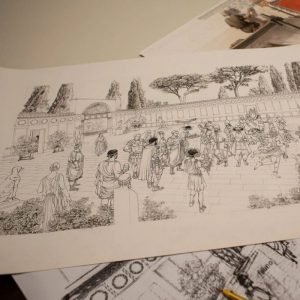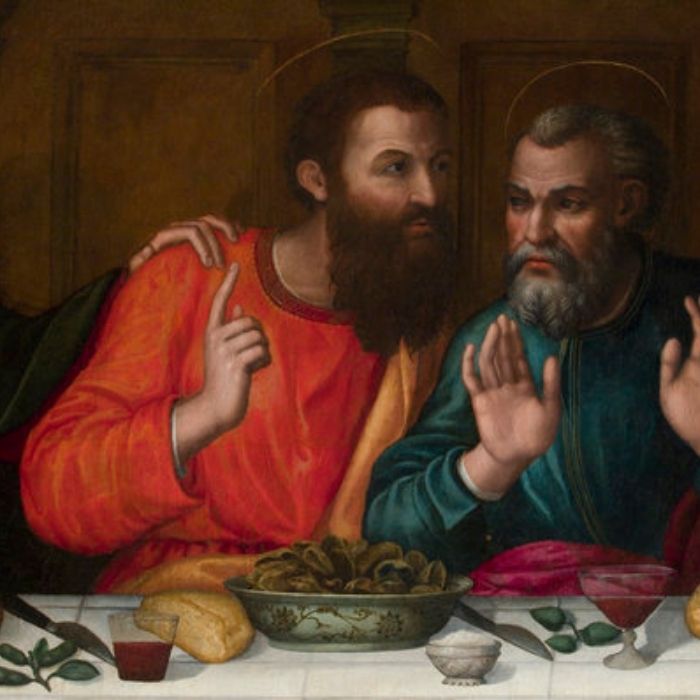Link About It: This Week’s Picks
Recognition for women artists, an extension to NYC’s High Line, autonomous car racing and more

The Mission to Spotlight Women Artists During the Renaissance Era
 Since its inception in 2009, Advancing Women Artists (AWA) has identified 2,000+ works by women artists tucked away in Italy’s museums, churches and beyond. The non-profit also funded the restoration of 70 more pieces spanning the 16th and 17th centuries. All of this encompasses their mission: to fight for equitable representation in museums and scholarly art discussions. Their mission also occurs in the public sphere as well, since most of these women have been stripped from conversations about art in the Renaissance Era. “Women didn’t have citizenship. They couldn’t produce art as a profession. They couldn’t issue invoices. They couldn’t study anatomy,” Linda Falcone, AWA’s director, tells NPR. Working to restore the physical paintings also fulfills a personal quest for better representation—and retroactive recognition of so many women artists. “Art is a living entity and a piece of art has its life. You know, it gets hurt. It gets damaged. It needs renewal. It needs to be talked about and paid attention to, et cetera,” Falcone continues. Read more at NPR.
Since its inception in 2009, Advancing Women Artists (AWA) has identified 2,000+ works by women artists tucked away in Italy’s museums, churches and beyond. The non-profit also funded the restoration of 70 more pieces spanning the 16th and 17th centuries. All of this encompasses their mission: to fight for equitable representation in museums and scholarly art discussions. Their mission also occurs in the public sphere as well, since most of these women have been stripped from conversations about art in the Renaissance Era. “Women didn’t have citizenship. They couldn’t produce art as a profession. They couldn’t issue invoices. They couldn’t study anatomy,” Linda Falcone, AWA’s director, tells NPR. Working to restore the physical paintings also fulfills a personal quest for better representation—and retroactive recognition of so many women artists. “Art is a living entity and a piece of art has its life. You know, it gets hurt. It gets damaged. It needs renewal. It needs to be talked about and paid attention to, et cetera,” Falcone continues. Read more at NPR.
Image courtesy of Rabatti & Domingie Firenze / AWA
Indianapolis Motor Speedway to Host First-Ever High-Speed Autonomous Car Race
 The first car penciled in to compete at 2021’s inaugural Indy Autonomous Challenge was unveiled at the CES all-digital 2021 show by Energy Systems Network, Penske Entertainment Corp, Dallara and the Indianapolis Motor Speedway. Set for October, the race will feature 40 teams comprised of university students from all over the world. These teams will build the software necessary to achieve top speeds over 200mph. A Dallara-made chassis typically used in the Indy Lights Series will be the physical base. Though the racetrack differs from city streets or interstate highways (where consumers are eager for autonomous tech), this concentrated competition aims to foster innovation that could be applied there. The self-driving technology will be tested at top speeds and in the split-second situations in which a human driver would have life or death reactions. Read more at Inside Indiana Business.
The first car penciled in to compete at 2021’s inaugural Indy Autonomous Challenge was unveiled at the CES all-digital 2021 show by Energy Systems Network, Penske Entertainment Corp, Dallara and the Indianapolis Motor Speedway. Set for October, the race will feature 40 teams comprised of university students from all over the world. These teams will build the software necessary to achieve top speeds over 200mph. A Dallara-made chassis typically used in the Indy Lights Series will be the physical base. Though the racetrack differs from city streets or interstate highways (where consumers are eager for autonomous tech), this concentrated competition aims to foster innovation that could be applied there. The self-driving technology will be tested at top speeds and in the split-second situations in which a human driver would have life or death reactions. Read more at Inside Indiana Business.
Image courtesy of Energy Systems Network
Extensions Planned for NYC’s High Line
 An L-shaped extension to NYC’s High Line is set to connect the elevated park to the just-opened Moynihan Train Hall at Penn Station. Currently the High Line reaches 10th Ave and 30th St, but an extra 1200 feet (366 meters) will bring it to 31st St between 9th and 10th Ave—where the Manhattan West development exists, a block from Moynihan Train Hall. The intention is to provide a central, commuter-friendly path into the park, which currently runs along Manhattan’s far west side. The project is set to cost $60 million, and will be funded by New York State, the Port Authority of New York and New Jersey, Friends of the High Line and Brookfield Property Partners. Governor Cuomo, who announced the expansion this week, hasn’t mention when work will begin and as Gothamist notes, it’s “not immediately clear what role city agencies would play in the approval process.” Read more there.
An L-shaped extension to NYC’s High Line is set to connect the elevated park to the just-opened Moynihan Train Hall at Penn Station. Currently the High Line reaches 10th Ave and 30th St, but an extra 1200 feet (366 meters) will bring it to 31st St between 9th and 10th Ave—where the Manhattan West development exists, a block from Moynihan Train Hall. The intention is to provide a central, commuter-friendly path into the park, which currently runs along Manhattan’s far west side. The project is set to cost $60 million, and will be funded by New York State, the Port Authority of New York and New Jersey, Friends of the High Line and Brookfield Property Partners. Governor Cuomo, who announced the expansion this week, hasn’t mention when work will begin and as Gothamist notes, it’s “not immediately clear what role city agencies would play in the approval process.” Read more there.
Image courtesy of Office of Gov Andrew Cuomo
Unearthed Treasures From Tyrant Caligula’s Garden of Delights
 First-century tyrant Caligula used a magical estate and its accompanying garden as a retreat during his four-year reign. (He was also assassinated there.) On the outskirts of Rome, on Esquiline Hill, Caligula housed imported animals and oddities, oversaw the construction of an exquisite botanical complex and leveraged his wealth. Scholars believed that when he died, his estate was likely pillaged and the belongings unlikely to be recovered. But a dig that began in the 19th century under a condemned apartment building yielded a bounty that forms the basis of a new museum established by Italy’s Ministry of Cultural Heritage, Cultural Activities and Tourism. Nymphaeum Museum of Piazza Vittorio (as its called) will display excavated parts of the original garden and many of the items once inside the accompanying estate—everything from gems, coins and ceramics to citron, apricot and acacia, bones of peacocks and bears, and beyond. Read more at The New York Times.
First-century tyrant Caligula used a magical estate and its accompanying garden as a retreat during his four-year reign. (He was also assassinated there.) On the outskirts of Rome, on Esquiline Hill, Caligula housed imported animals and oddities, oversaw the construction of an exquisite botanical complex and leveraged his wealth. Scholars believed that when he died, his estate was likely pillaged and the belongings unlikely to be recovered. But a dig that began in the 19th century under a condemned apartment building yielded a bounty that forms the basis of a new museum established by Italy’s Ministry of Cultural Heritage, Cultural Activities and Tourism. Nymphaeum Museum of Piazza Vittorio (as its called) will display excavated parts of the original garden and many of the items once inside the accompanying estate—everything from gems, coins and ceramics to citron, apricot and acacia, bones of peacocks and bears, and beyond. Read more at The New York Times.
Image courtesy of Nadia Shira Cohen for The New York Times
Link About It is our filtered look at the web, shared daily in Link and on social media, and rounded up every Saturday morning. Hero image courtesy of Ottaviano Caruso / AWA











